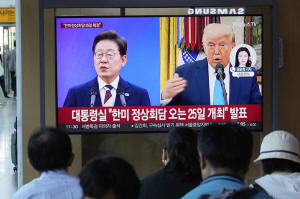South Korean President Lee will travel to Washington for Aug. 25 meeting
with Trump
[August 12, 2025] By
KIM TONG-HYUNG
SEOUL, South Korea (AP) — South Korea’s new President Lee Jae Myung will
travel to Washington later this month to meet with U.S. President Donald
Trump, Lee’s office said Tuesday, for talks on trade and defense
cooperation in the face of nuclear-armed North Korea and other threats.
Their Aug. 25 summit will follow a July trade deal in which Washington
agreed to cut its reciprocal tariff on South Korea to 15% from the
initially proposed 25% and to apply the same reduced rate to South
Korean cars, the country’s top export to the United States.
South Korea also agreed to purchase $100 billion in U.S. energy and
invest $350 billion in the country, and Lee and Trump may discuss how
the investment package will be structured and managed. The talks are
expected to cover expanding cooperation in key industries such as
semiconductors, batteries and shipbuilding, Lee’s spokesperson Kang Yu-jung
said.
Lee, a liberal who won an early election in June to replace ousted
conservative Yoon Suk Yeol, has made the economy his top priority,
aiming to shield the trade-dependent nation from the shocks of Trump’s
tariff hikes and his demands that allies cut reliance on Washington and
shoulder more of their own defense costs.
Lee's meeting with Trump comes amid concerns in Seoul that the Trump
administration could shake up the decades-old alliance by demanding
higher payments for the U.S. troop presence in South Korea and possibly
move to reduce it as Washington shifts more focus on China.

Lee and Trump will discuss strengthening the allies’ defense posture
against growing North Korean threats, and also developing the
partnership into a “future-oriented, comprehensive strategic alliance”
to address the changing international security and economic environment,
according to Kang, who didn’t elaborate on the specific issues to be
addressed.
Dating back to his first term, Trump has regularly called for South
Korea to pay more for the 28,500 American troops stationed on its soil.
Recent comments by key Trump administration officials, including
Undersecretary of Defense Elbridge Colby, have also suggested a desire
to restructure the alliance, which some experts say could potentially
affect the size and role of U.S. forces in South Korea.
Under this approach, South Korea would take a greater role in countering
North Korean threats while U.S. forces focus more on China, possibly
leaving Seoul to face reduced benefits but increased costs and risks,
experts say.
In a meeting with South Korean reporters last week, Gen. Xavier Brunson,
commander of U.S. Forces Korea, stressed the need to “modernize” the
alliance to address the evolving security environment, including North
Korea’s expanding nuclear program, its deepening alignment with Russia,
and what he called Chinese threats to a “free and open Indo-Pacific.”
[to top of second column] |

People watch a TV screen showing a file image of South Korean
President Lee Jae Myung, left, and U.S. President Donald Trump
during a news program at the Seoul Railway Station in Seoul, South
Korea, Tuesday, Aug. 12, 2025. The signs read, "The presidential
office announced that the South Korea-U.S. summit will be held on
the 25th." (AP Photo/Ahn Young-joon)
 When asked about a potential
reduction in U.S. troops in South Korea, Brunson emphasized
capabilities over numbers, highlighting advanced systems like
fifth-generation fighters, and also stressed strategic flexibility,
citing the recent deployment of Patriot air defense systems from
South Korea to the Middle East.
“What’s being asked of Korea is to be stronger against DPRK — that
we might have the flexibility as we modernize our alliance so that
we could go do other things,” Brunson said, using the initials of
North Korea’s formal name, the Democratic People’s Republic of
Korea.
During his first term, Trump suspended U.S. military exercises with
South Korea while pursuing diplomacy with North Korean leader Kim
Jong Un. They met three times in 2018 and 2019 but their diplomacy
quickly collapsed over disagreements about exchanging the release of
U.S.-led sanctions against the North and the North’s steps to wind
down its nuclear and missile program.
Kim has since suspended virtually all diplomacy with Washington and
Seoul while accelerating the expansion of his weapons program. His
foreign policy priority is now Russia, which he has supplied with
weapons and troops to help prolong Russian President Vladimir
Putin’s invasion of Ukraine.
Kim’s powerful sister recently dismissed Washington and Seoul’s
stated desires to restart diplomacy aimed at defusing the North’s
nuclear program, indicating that Pyongyang feels no urgency to
resume diplomacy with South Korea and the U.S. anytime soon.
Tensions on the peninsula could rise again later this month, when
South Korea and the United States proceed with their annual
large-scale combined military exercises, which begin on Aug. 18.
North Korea labels the allies’ joint drills as invasion rehearsals
and often uses them as a pretext to dial up military demonstrations
and weapons tests aimed at advancing its nuclear program.
All contents © copyright 2025 Associated Press. All rights reserved
 |